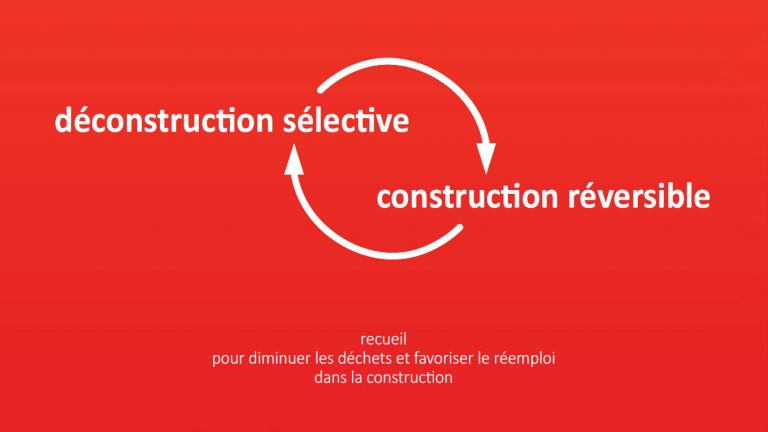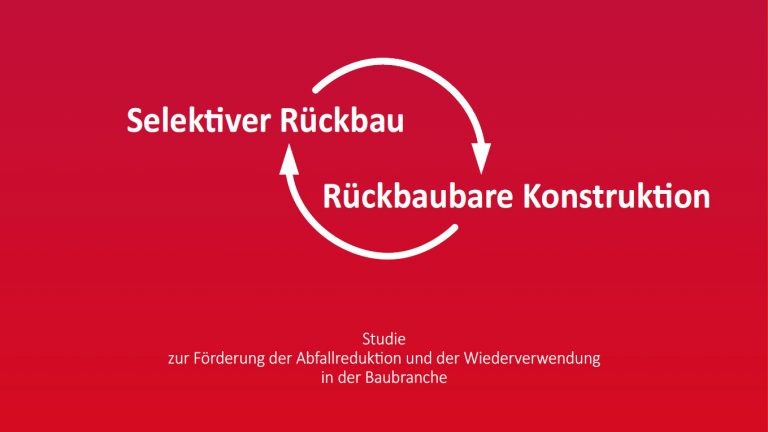selective deconstruction / reversible construction

Dismantling of the Rive's granary in Geneva, Switzerland, 1897 (credits: Boissonnaz, Geneva Library)

book download FR | Déconstruction sélective – Construction Réversible: recueil pour diminuer les déchets et favoriser le réemploi dans la construction

book download DE | Selektiver Rückbau – Rückbaubare Konstruktion: Studie zur Förderung der Abfallreduktion und der Wiederverwendung in der Baubranche
“Selective deconstruction – reversible construction: Compendium to decrease waste and encourage component reuse in the construction industry” is a book mandated by the Swiss Federal Office for the Environment (FOEN). Through a literature review, 32 case studies, and interviews with practitioners, the 160-page long book:
- synthesises the fundamental principles of both approaches;
- documents and disseminates feedback and good practice;
- provides contractors, designers and clients with technical references;
- provides stakeholders with a detailed, state-of-the-art theoretical background and a set of references to take them further;
- outlines the prospects for development and opportunities applicable to the Swiss building sector.
The book is available in French and German, free to download on the FOEN’s official libraries (FR, DE) on waste management .
Please note that the publication lists from Infoscience integrated into the EPFL website, lab or people pages are frozen following the launch of the new version of platform. The owners of these pages are invited to recreate their publication list from Infoscience. For any assistance, please consult the Infoscience help or contact support.
Déconstruction sélective – Construction Réversible: recueil pour diminuer les déchets et favoriser le réemploi dans la construction
A travers une revue de la littérature, ainsi que 32 études de cas et des entretiens avec des praticiens, ce recueil: › synthétise les principes fondamentaux des deux approches; › documente et diffuse les retours d’expériences et les bonnes pratiques; › apporte aux entrepreneurs/entrepreneuses, concepteurs/conceptrices et maîtrises d’ouvrage des références techniques; › procure aux parties prenantes un bagage théorique à la pointe et détaillé ainsi qu’une série de référence pour aller plus loin; › esquisse les perspectives d’évolution et opportunités applicables au bâti suisse.
Lausanne, Switzerland: EPFL, 2021-09-01.DOI : 10.5281/zenodo.4314325
Please note that the publication lists from Infoscience integrated into the EPFL website, lab or people pages are frozen following the launch of the new version of platform. The owners of these pages are invited to recreate their publication list from Infoscience. For any assistance, please consult the Infoscience help or contact support.
Selektiver Rückbau – Rückbaubare Konstruktion: Studie zur Förderung der Abfallreduktion und der Wiederverwendung in der Baubranche
Diese Sammlung stützt sich auf eine Literaturrecherche sowie 32 Fallstudien und Interviews mit Fachkräften und: › fasst die Grundprinzipien beider Ansätze zusammen; › dokumentiert und gibt Erfahrungsberichte und bewährte Verfahren weiter; › liefert technische Referenzen für Bauunternehmen, Entwerferinnen/Entwerfer und Bauherrschaft; › bietet einen aktuellen und detaillierten theoretischen Hintergrund sowie Referenzen für die weitere Entwicklung; › skizziert die Möglichkeiten zur Weiterentwicklung und Umsetzung für Schweizer Bauten.
Lausanne, Switzerland: EPFL, 2021-09-01.DOI : 10.5281/zenodo.5131243
direction:
- Corentin Fivet, EPFL
drafting:
- Célia Küpfer, EPFL
- Corentin Fivet, EPFL
new illustrations & copyright queries:
- Julie Allémann, EPFL
- Maxence Grangeot, EPFL
- Célia Küpfer, EPFL
reviewing:
- Julien Grisel, bunq architectes
- Catherine de Wolf, EPFL
- Maléna Bastien Masse, EPFL
- Barbara Lambec, EPFL
- Jan Brütting, EPFL
translation to German:
- Nina Haftka, EPFL
- Jan Brütting, EPFL
mandator:
- Office Fédéral de l’Environnement ∙ http://www.ofev.ch
Division Déchets et Matières Premières
Section Cycles matières premières
CH-3003 Berne, Suisse
Dr. David Hiltbrunner (contact person)